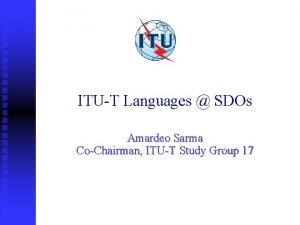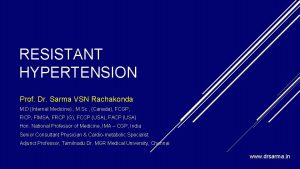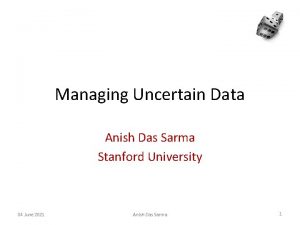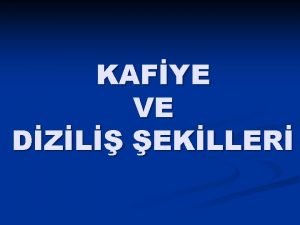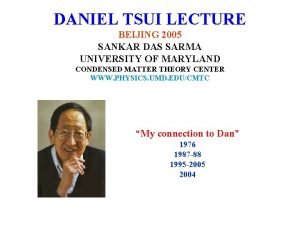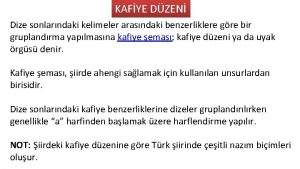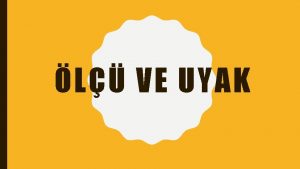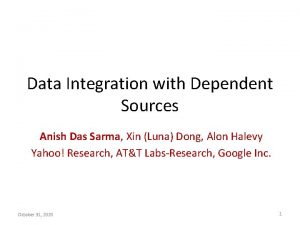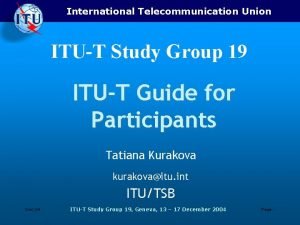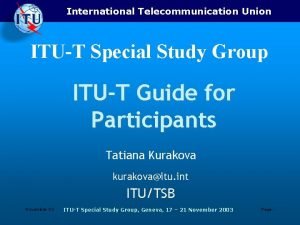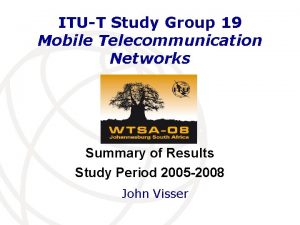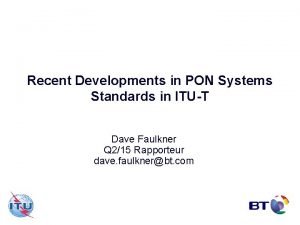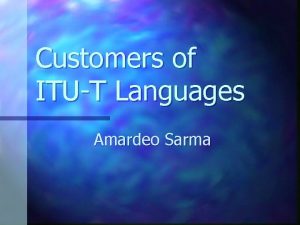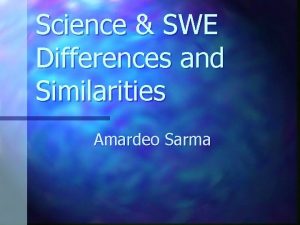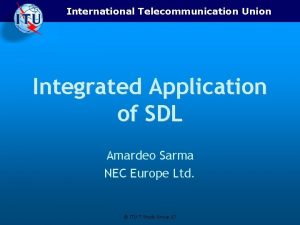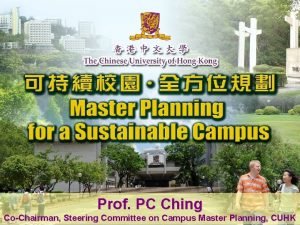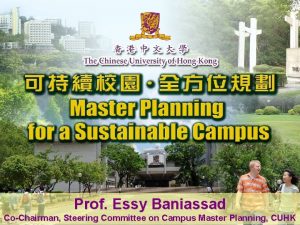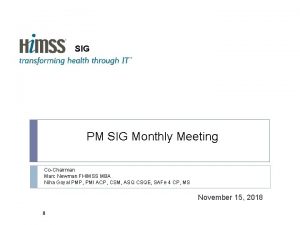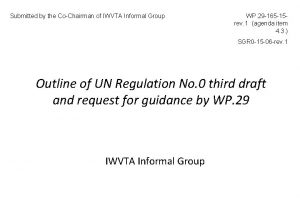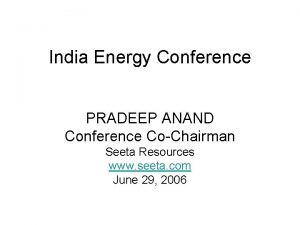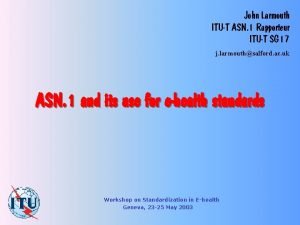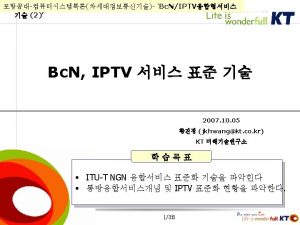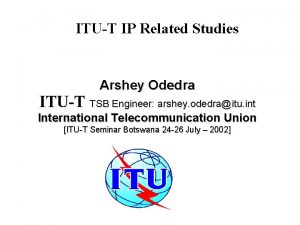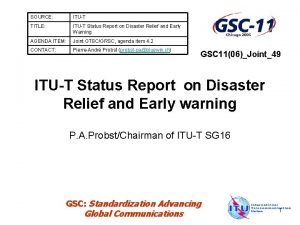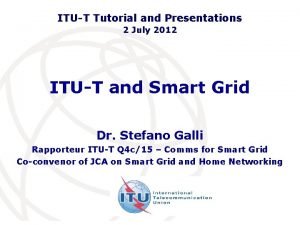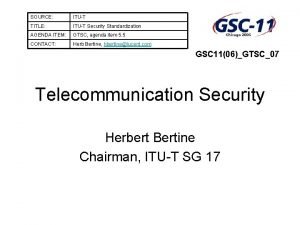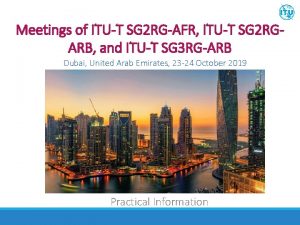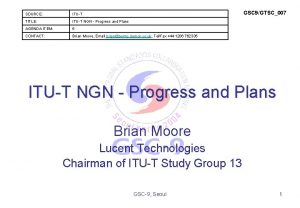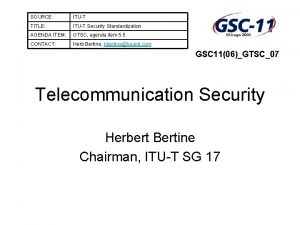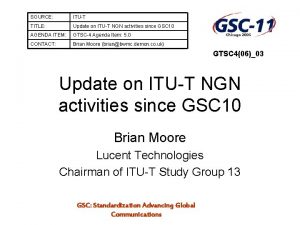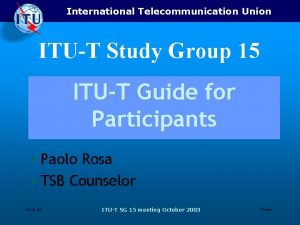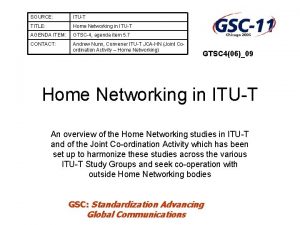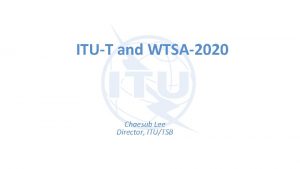The Language Family ITUT Amardeo Sarma CoChairman ITUT







































- Slides: 39

The Language Family @ ITU-T Amardeo Sarma Co-Chairman, ITU-T Study Group 17

Contents Languages at SG 17 n ITU-T Languages u SDL u ASN. 1 u MSC u TTCN n Helping you make better standards faster n ITU-T Study Group 17

Languages at SG 17

Core Competencies at ITU-T n Carrier class standards and specifications u Quality of standards play a key role n Experts and drivers in Telecommunications Strong organisational and logistic support by the TSB Fast standards track u We need to make even better standards faster n n ITU-T Study Group 17

Mandate of ITU-T Study Group 17 n n Responsible for technical languages, the methods for their usage and other issues related to the software aspects of telecommunication systems. Studies on modelling, specification and description techniques and on other software aspects in line with the requirements of and in co-operation with the relevant other Study Groups (4, 11, 13, 16). SG 17 is Lead Study Group on Languages and Description Techniques within ITU-T SG 17 Policy: Strong coupling with industrial needs and use ITU-T Study Group 17

The ITU-T language family SDL - Specification and Description Language n MSC - Message Sequence Chart n ODL - Object Definition Language (adopted from TINA) n ASN. 1 - Abstract Syntax Notation One n TTCN Tree and Tabular Combined Notation n CHILL - CCITT HIgh-Level Language n ITU-T Study Group 17

The ITU-T language family (new) DCL - Distribution and Configuration Language n URN - User Requirements Notation n n Incorporating Time and Performance into the languages ITU-T Study Group 17

What makes the family different? n n n Real-time, distributed communicating systems Formal, allowing verification and validation Many languages with a graphical syntax Commercial tool support u Tool availability required for approval u Tools vendors directly involved in work Catering for users both in Industry and in Standards bodies (SDOs), e. g. ITU-T SG 11 ITU-T Study Group 17

Language Usage n n n Initially, languages were mainly aimed at standards and Recommendations For the core languages, industrial use has today far outgrown use in standards! The use at SDOs is below the potential to: u Improve quality of standards u Reduce time But: Use requires some investment Fora support ASN. 1, SDL, MSC and TTCN ITU-T Study Group 17

Our Strategy at ITU-T SG 17 Keep the edge by concentrating on the differentiating factors and focusing on our strengths ITU-T Study Group 17

ITU-T Languages

SDL n n Created for Telecommunications u Centred around the specification of behaviour, good for use in protocols u Allows specification of structure and data u Good tool support, including integration with other techniques u Widely used in standards and even more in industry Moving to other real-time application areas ITU-T Study Group 17

SDL hot issues n Upgrade of methodology UML-MSC-ASN. 1 -SDL-TTCN CIF for SDL-2000 MSC data mapping to SDL Time and performance features SDL as a UML profile (OMG? ) SDL components for sale n Gnu/Visual SDL? ? n n n ITU-T Study Group 17

ASN. 1 n n n International standard : ITU-T X. 680 to X. 683 | ISO/IEC 8824 -1 to 4 with a sizeable base of tools that support ASN. 1 Describes data exchange between two communicating applications Several associated standardized encodings, such as: u efficient (binary) encoding: Packed Encoding Rules (PER) u canonical encoding for digital signatures: Distinguished Encoding Rules (DER) u XML (textual) encoding rules (XER) with tool support Mature, long record of reliability and interoperability ASN. 1 is a critical part of our daily lives; it's everywhere, but it works so well it's invisible! ITU-T Study Group 17

ASN. 1 and the telecom industry n n n n n Intelligent network GSM UMTS (3 G cellphones) Voice over IP Interactive television Videoconference SET, C-SET (secured electronic transaction: e-commerce, m-commerce) Computer-supported telecommunications applications. . . ITU-T Study Group 17

ASN. 1 in other domains n n n n Intelligent transportation Radio-frequency identification (RFID) ATN (Aeronautical Telecommunication Network) Embedded systems Financial operations (ASC X. 9, ISO TC 68) Control of manufacturing systems And a lot of other application domains: see http: //asn 1. elibel. tm. fr/uses Fully integrated in the formal languages SDL and TTCN ITU-T Study Group 17

MSC Current Version: Previous Version: Next Version: Z. 1 20 MSC 2000 MSC ’ 96 MSC 2004 Standard consists of: • graphical grammar • ASCII grammar • static & dynamic semantics • formal semantics, Annex B • examples ITU-T Study Group 17

MSC n n MSC-2000 is a rich language with rigorously defined semantics, unlike UML sequence charts u One of the advantages over competitors MSC is widely, but informally, used often independently of other notations. u At IETF, MSC is clearly a candidate to formalise signal flows There is scope for increased tool/language penetration. Users are often unaware of Z. 120 as a standard for sequence diagrams and that MSC has good tool support. ITU-T Study Group 17

MSC Future Features n n Message Channels Presentation Formats u TTCN Graphical presentation format, Z. 142 u semantic restrictions, e. g. tracing Instantiations of Universal Data Interface u SDL interface scheduled 2002, Z. 121 u ASN. 1 interface? u TTCN-3 interface? UML alignment u OMG UML v 2. 0 sequence diagrams ITU-T Study Group 17

TTCN-3 Testing and Test Control Notation TTCN-3 is used to write detailed test specifications n Applicable to telecom and datacom testing n Application Areas u protocols u services u APIs u software modules etc. n ITU-T Study Group 17

A general purpose testing language Conformance Testing n Interoperability testing n Robustness testing n Performance testing n regression testing n System testing n Integration testing, etc. n ITU-T Study Group 17

TTCN-3: different presentation formats Text format Tabular Format TTCN-3 Core Language n n MSC Format n Presentation Format 3 n n Presentation Formatn n Core format is a text based language Core can be viewed as text or in various presentation formats Tabular format for conformance testing Message Sequence Chart (MSC)format Other standardized formats in the future Proprietary formats ITU-T Study Group 17

What about UML? SDL and MSC experts key for UML 2. 0 n Tools for joint support available n UML without SDL is like a car without an engine n Co-operation with OMG in progress n If you really want UML, you can use it without losing the benefits of SDL/MSC n ITU-T Study Group 17

What about XML? n n n ASN. 1 + XCN (XML Control Notation) u as powerful and expressive as XSD (XML Schema Definition) u less verbose and much more readable. ASN. 1 is a mature schema notation for XML. No schema mapping is needed ASN. 1/XER: efficient binary encodings with XML (+ XSL) display (or transfer if needed) CXER èASN. 1/XER as a canonical variant of XER for secured transactions XER tools : http: //asn 1. elibel. tm. fr/links/#xml ITU-T Study Group 17

UML and XML are easy and popular SDL and ASN. 1 support secure, hi-quality standards You use the best of two worlds ITU-T Study Group 17

The next years n n n After UML 2. 0, work together towards u Powerful, new versions of SDL and MSC u Strong bridges to ASN. 1 and TTCN in addition to UML Consolidate and strengthen the use of languages in Telecommunications Expand further into new domains Focus on penetrating the IETF in the coming years Support standardisation and education with tools ITU-T Study Group 17

Helping you make better standards fast

What ITU-Languages do for you n n n Provide a method supported by commercial and free tools Allow checking of syntactical and logical (semantic) correctness on the fly Helps you check if the behaviour is what you intended Improves the quality of the standard u Interoperability is greatly improved Once used properly, helps save time! ITU-T Study Group 17

Obstacles to Language Use n Benefit unclear u Check track record n Formality reduces freedom u Freedom only reduced for issues needed for interoperation, use correct dose of formality Quick and dirty is better u This is not ITU-T‘s differentiator or unique selling point n ITU-T Study Group 17

Obstacles to Language Use n n n No expertise in group u Specialists should concentrate on their domain – get support for languages No time u Check whether overall time is lost or gained Missing support u TSB should provide this! u Or ask SG 17 – we could e. g. provide tutorials in SDL, ASN. 1 etc. ITU-T Study Group 17

Tool usage at ITU-T n n n SDT is currently the standard tool at ITU and ETSI Recommendation authors send SDT files, which are checked by TSB staff Formal descriptions are considered non-coprighted Common Interchange Format CIF is very important (e. g. for those using Cinderella)! Availability of cheap or free lightweight tool for standards greatly helps promote SDL/MSC u The ITU-T CD-ROM, also available for you all, has been a step in this direction! ITU-T Study Group 17

Professional support is needed! n n To further improve standards quality, SG 17 reinforced the recommendation that TSB provide u expertise on a regular basis in the ITU-T languages and methodologies concerning the use of the languages u tools, supporting and facilitating the use of ITUT languages We really need permanent experts at ITU-T: u ETSI success story u Demand must come from users ITU-T Study Group 17

ITU-T languages can help ITU-T Recommendations maintain or regain competitive advantage


Support from Fora and Consortia ASN. 1 Consortium: http: //www. asn 1. org n SDL Forum Society: http//www. sdlforum. org n Indian SDL and TTCN Forum: http: //www. sdl-ttcnforum. org/ n ITU-T Study Group 17

ASN. 1 Consortium n n n Group of ASN. 1 users (people and companies), specifiers and tool-vendors Share resources and information Promote ASN. 1 (towards newspaper and journals, companies, universities…) No standardization work Three forums: • Industry forum • Standardization forum • Academic forum Website: http: //www. asn 1. org ITU-T Study Group 17

ASN. 1 – short summary n n n n Robust and stable technology that has withstood the test of time, and which continues to improve over time. Now supports XML in ITU-T X. 693 (XML Encoding Rules) An easier schema for XML than W 3 C XML Schema (XSD) Makes it possible to use XML where it currently is impossible due to XML's verbose size ITU-T X. 694 now makes it possible to convert XSD to ASN. 1 A sizeable base of tools that support ASN. 1, including PER and XML, now exists The rapid degree of ASN. 1: 2002 features implemented by tool vendors is a testament to the strength of the ASN. 1 industry. ITU-T Study Group 17

TTCN-3 and Other Languages n ASN. 1 Types & Values Other types & Values 2 Other types & Valuesn TTCN-3 Core Language n n TTCN can be integrated with other 'type and value' systems Fully harmonized with ASN. 1 (1997) Harmonization possible with other type and value systems (possibly from proprietary languages) ITU-T Study Group 17

Major Elements of TTCN-3 Core n Data Types Test Data Test System Architecture Test Behaviour n n n Built-in and user-defined generic data types (e. g. , to define messages, service primitives, information elements, PDUs) Actual test data transmitted/received during testing Definition of the components and communication ports that are used to build various testing configurations Specification of the dynamic test system behaviour ITU-T Study Group 17
 Amardeo sarma
Amardeo sarma Uyak
Uyak Dr sarma vsn rachakonda
Dr sarma vsn rachakonda Anish das sarma
Anish das sarma Düz uyak
Düz uyak Sankar das sarma
Sankar das sarma Vertailujärjestys
Vertailujärjestys Kafiye düzeni
Kafiye düzeni Aabb uyak
Aabb uyak Anish das sarma
Anish das sarma Itu t study groups
Itu t study groups Ittut
Ittut Itut
Itut Cabs.itut
Cabs.itut Cabs itut
Cabs itut Hình ảnh bộ gõ cơ thể búng tay
Hình ảnh bộ gõ cơ thể búng tay Frameset trong html5
Frameset trong html5 Bổ thể
Bổ thể Tỉ lệ cơ thể trẻ em
Tỉ lệ cơ thể trẻ em Voi kéo gỗ như thế nào
Voi kéo gỗ như thế nào Chụp tư thế worms-breton
Chụp tư thế worms-breton Alleluia hat len nguoi oi
Alleluia hat len nguoi oi Các môn thể thao bắt đầu bằng từ đua
Các môn thể thao bắt đầu bằng từ đua Thế nào là hệ số cao nhất
Thế nào là hệ số cao nhất Các châu lục và đại dương trên thế giới
Các châu lục và đại dương trên thế giới Công của trọng lực
Công của trọng lực Trời xanh đây là của chúng ta thể thơ
Trời xanh đây là của chúng ta thể thơ Cách giải mật thư tọa độ
Cách giải mật thư tọa độ Phép trừ bù
Phép trừ bù độ dài liên kết
độ dài liên kết Các châu lục và đại dương trên thế giới
Các châu lục và đại dương trên thế giới Thể thơ truyền thống
Thể thơ truyền thống Quá trình desamine hóa có thể tạo ra
Quá trình desamine hóa có thể tạo ra Một số thể thơ truyền thống
Một số thể thơ truyền thống Cái miệng nó xinh thế chỉ nói điều hay thôi
Cái miệng nó xinh thế chỉ nói điều hay thôi Vẽ hình chiếu vuông góc của vật thể sau
Vẽ hình chiếu vuông góc của vật thể sau Biện pháp chống mỏi cơ
Biện pháp chống mỏi cơ đặc điểm cơ thể của người tối cổ
đặc điểm cơ thể của người tối cổ V. c c
V. c c Vẽ hình chiếu đứng bằng cạnh của vật thể
Vẽ hình chiếu đứng bằng cạnh của vật thể
